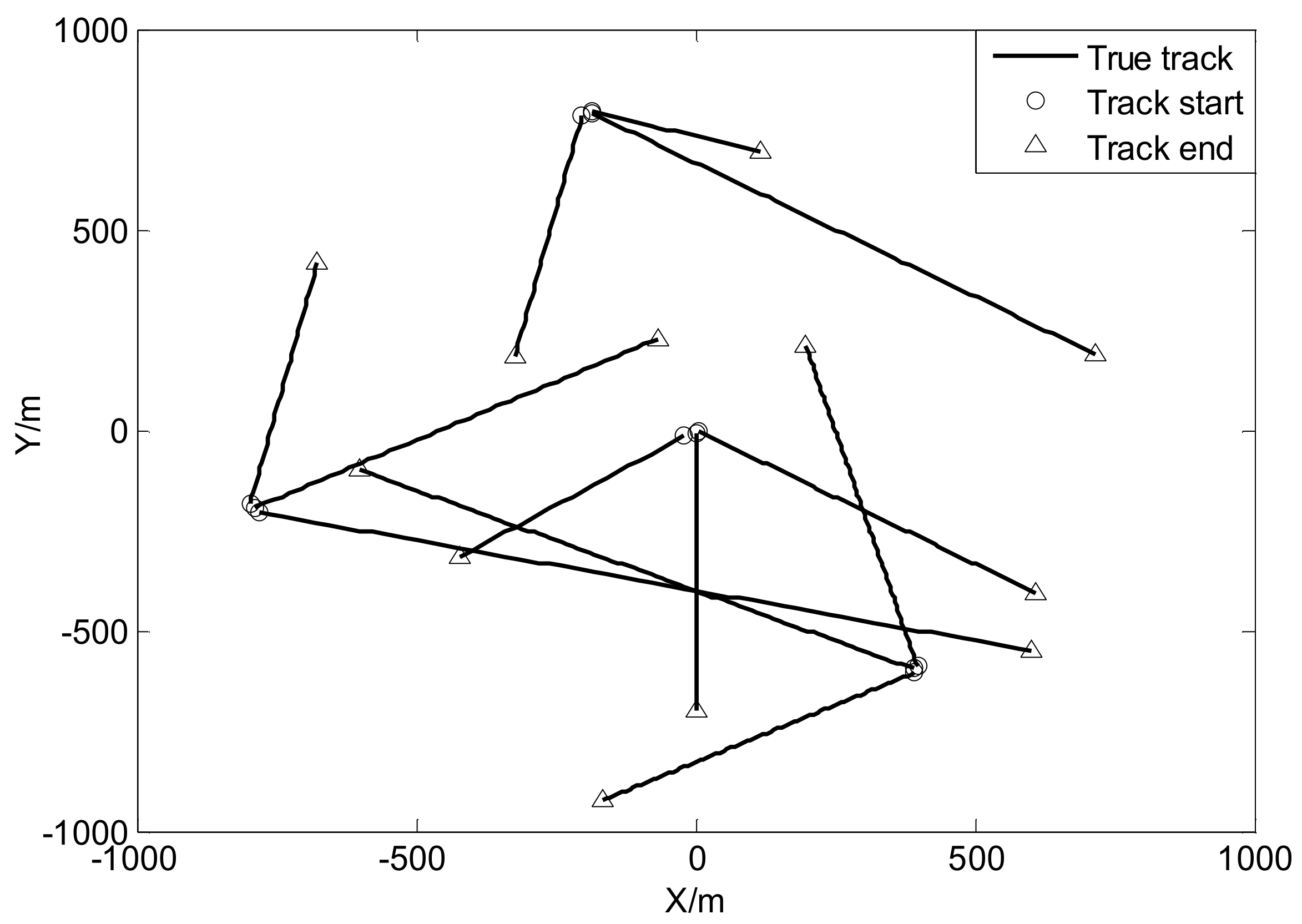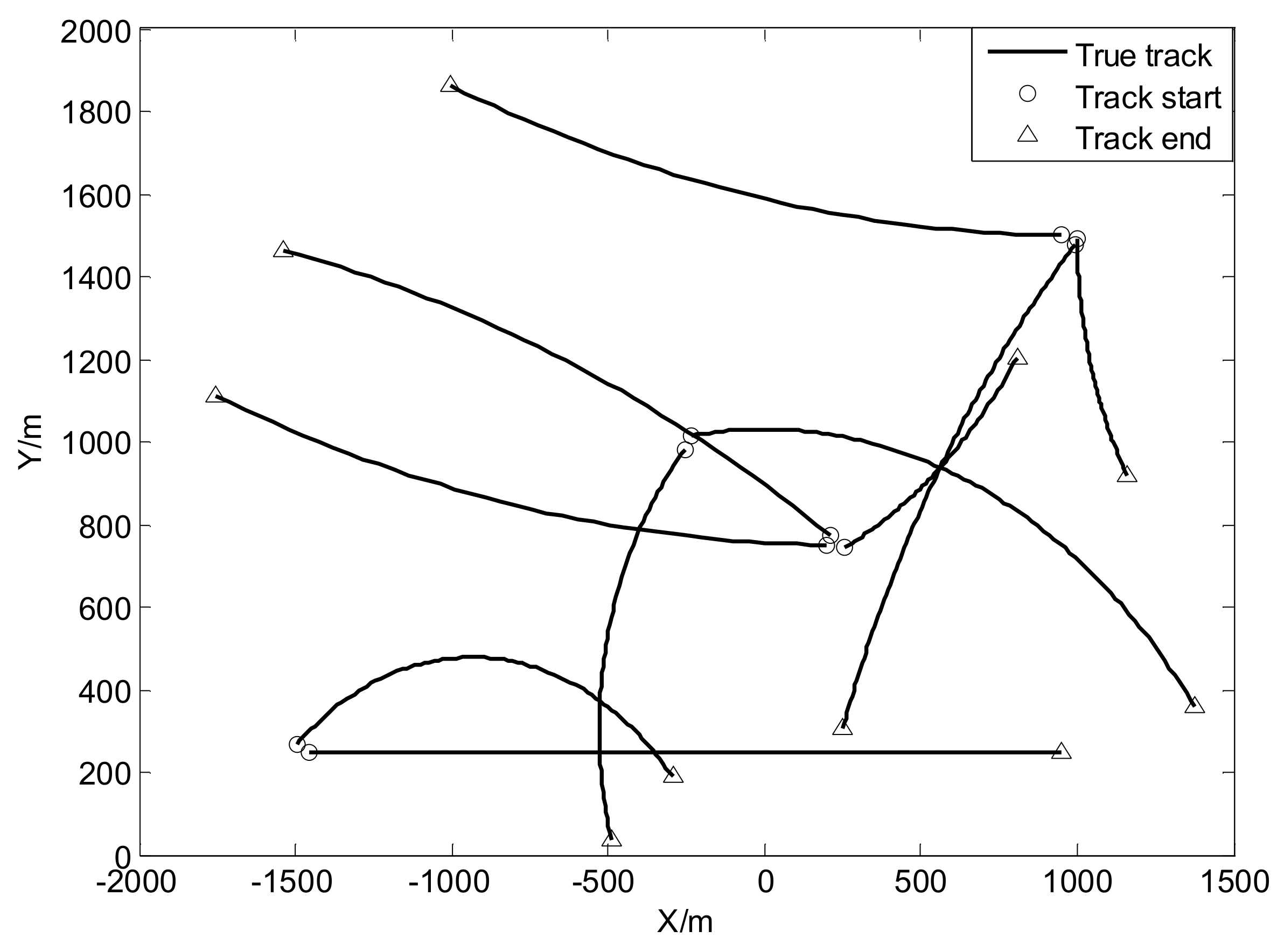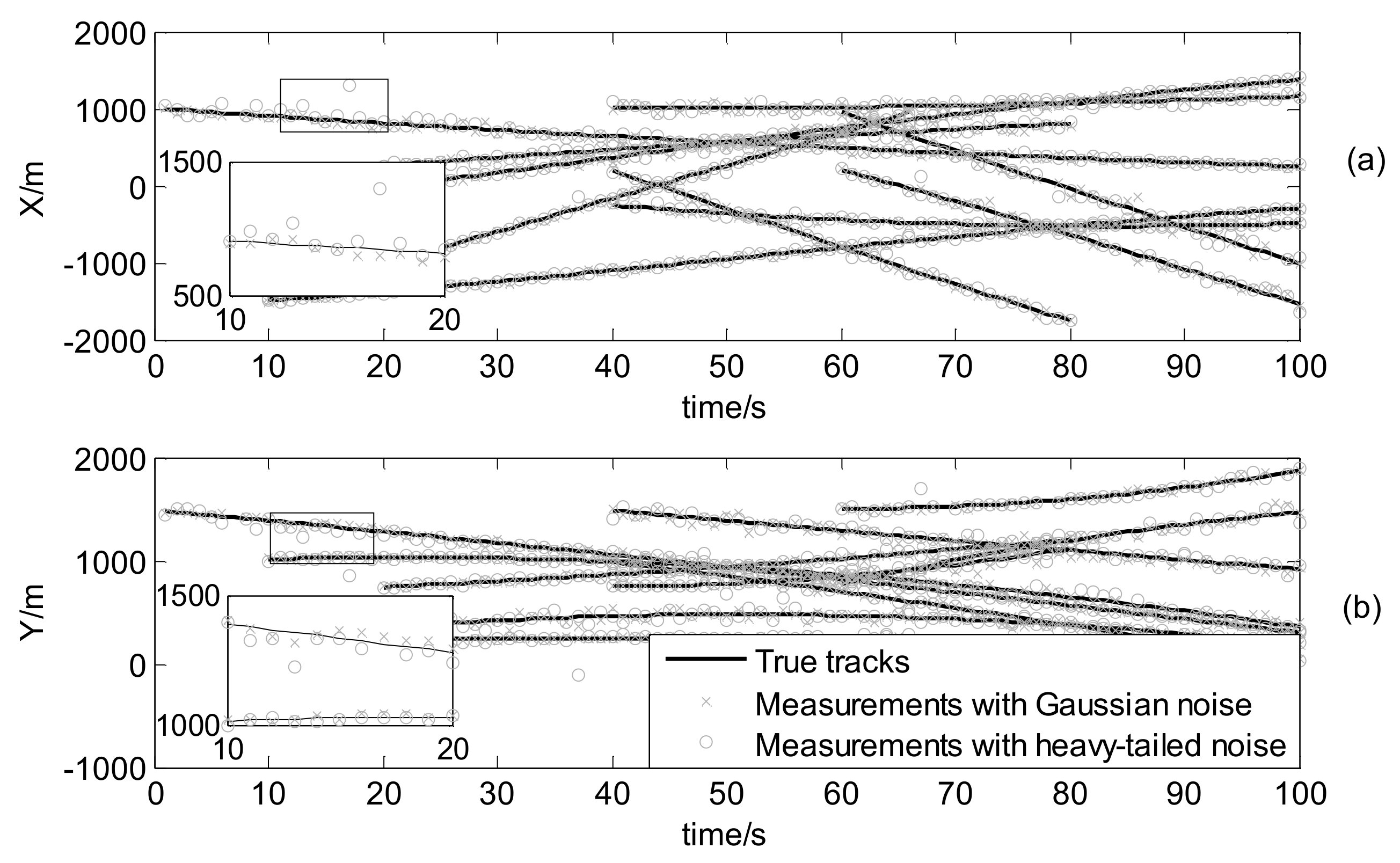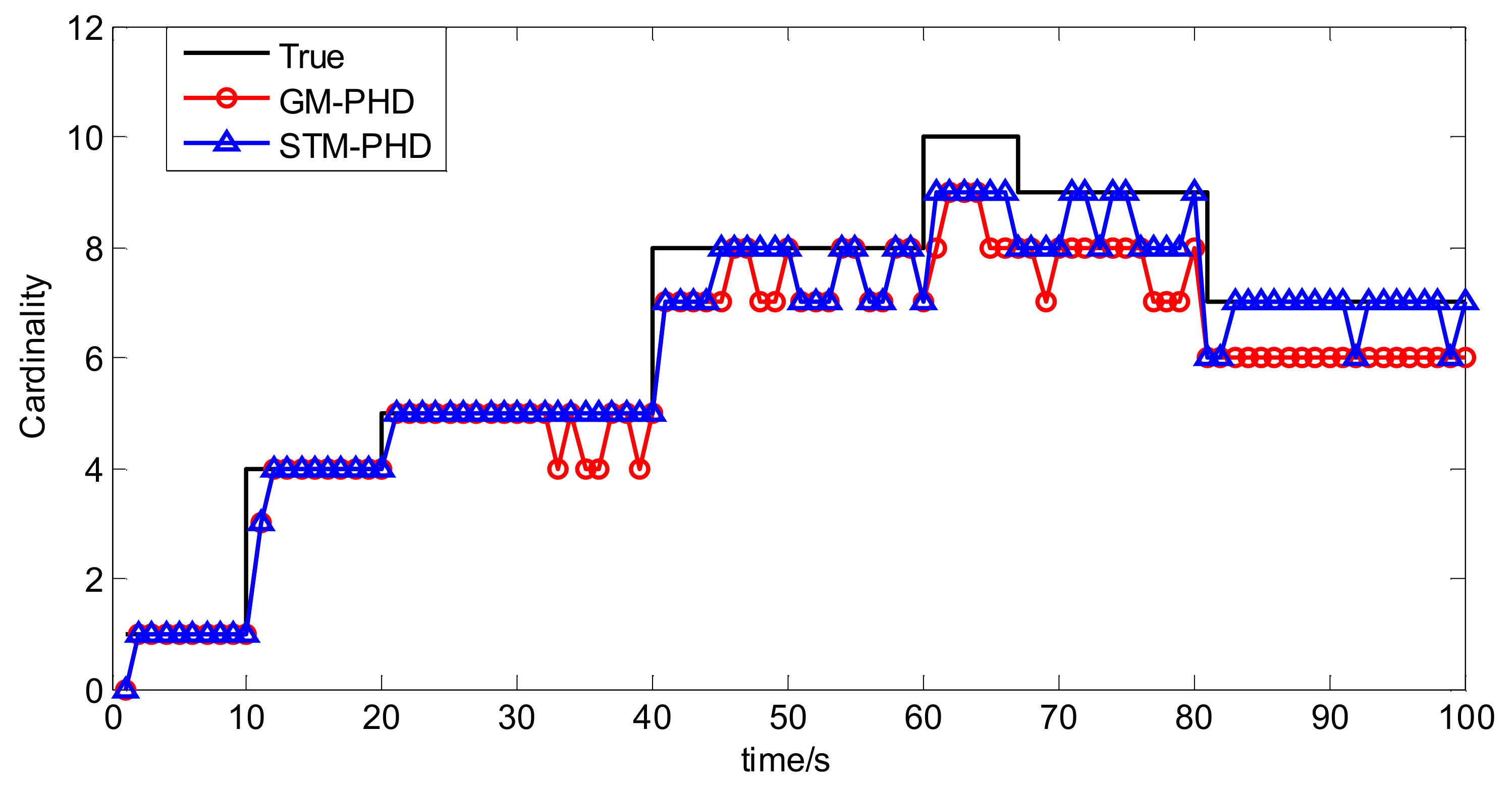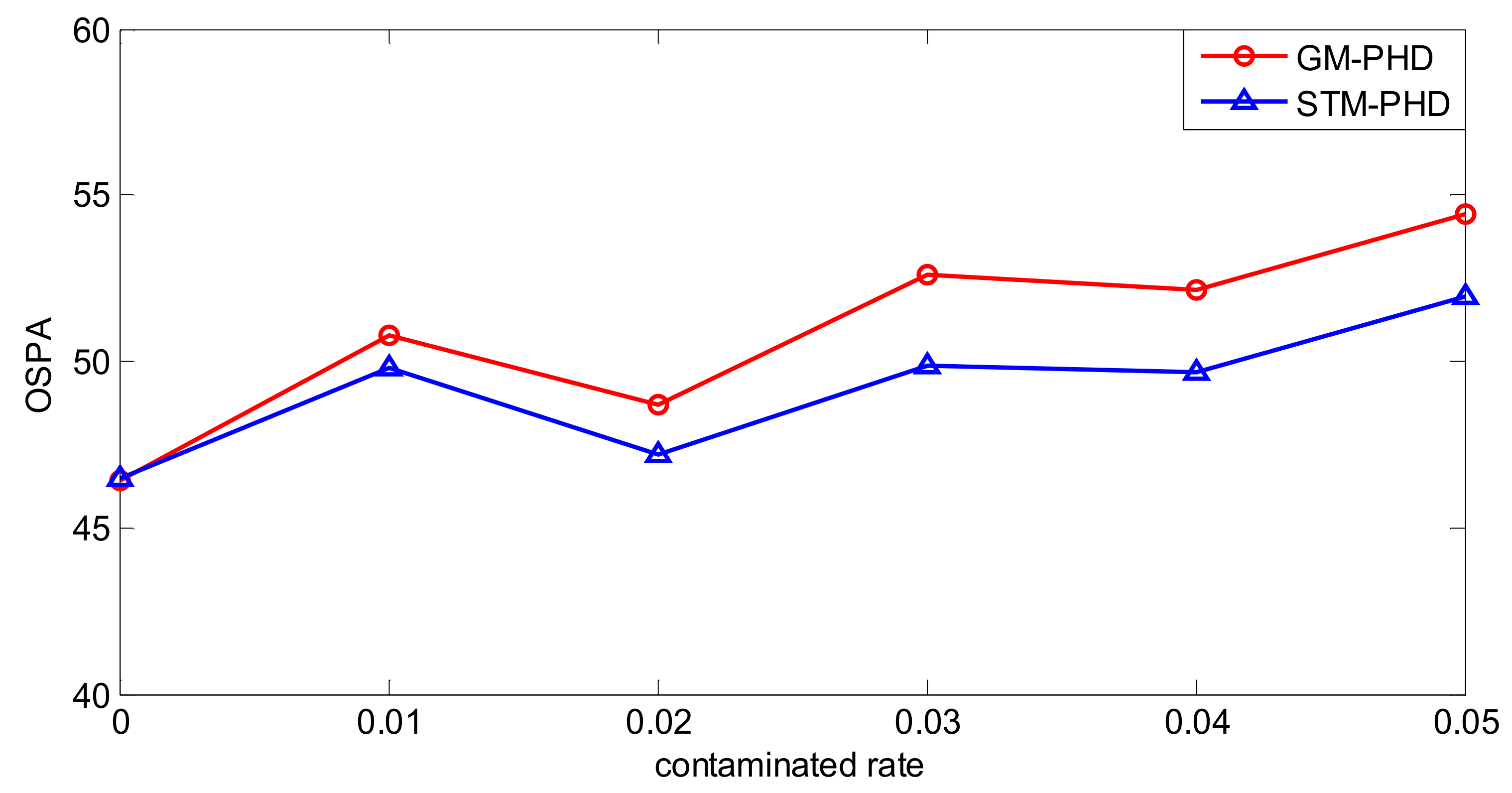1. Introduction
Multi-target tracking (MTT) plays an important role in many sensing systems, such as infrared, radar, sonar, etc., which uses the sensor data to jointly estimate the target state and the number of targets. Nowadays it is widely used in civilian and military applications such as air traffic control, remote sensing, ballistic missile guidance, and computer vision [
1,
2]. In MTT, the time-varying number of targets causes a problem in that the associations between state and measurement sets of targets are hard to know, which makes the traditional data association-based multi-target tracking methods problematic. In recent years, the random finite set (RFS) theory-based multi-target tracking filters, such as probability hypothesis density (PHD) filter [
3], cardinalized PHD (CPHD) filter [
4], multi-target multi-Bernoulli (MeMber) filter [
1] and cardinality-balanced MeMBer (CBMeMBer) filter [
5], have attracted much more attention since they can avoid the combinatorial problem that arises from data association. Moreover, some labeled RFS-based multi-Bernoulli filters [
6,
7] which can accommodate target tracks were proposed.
The focus of this paper is the PHD filter, which has relatively simple recursion, making it suitable for the applications demanding real time results. The PHD filter provides a tractable sub-optimal strategy for jointly estimating the number and the state of a variable number of targets by propagating the first-order statistical moment of multi-target posterior probability density in time. It has two basic implementations: the sequential Monte Carlo (SMC) method [
8] and the Gaussian mixture (GM) method [
9] which can solve the problem of computationally intractable multiple integrals involved in the PHD recursions. Compared to SMC implementation, GM implementation of the PHD filter has the advantages of simple state extraction and low computational cost, which is suitable for the requirement of real-time scenes. Moreover, some nonlinear extensions [
9,
10,
11] and improvements [
12,
13,
14] extend the scope of applications for the GM-PHD filter.
In MTT, noise, as the important part of measurement uncertainty, is an inevitable problem that reduces estimation accuracy of the PHD filter. Vo [
15] thought that the setting of a reasonably large noise variance can accommodate noise interference in most situations. However, this method is only suitable for Gaussian noise. In real applications, it is hard for the measurement noise from sensor data to follow the Gaussian distribution because of electromagnetic interference or sensors’ own unreliability. Such measurements with outliers, which often express heavy-tailed character, degrade the performance of the PHD filter strikingly. What’s worse, in some real applications, such as tracking some agile targets with unreliable sensors, outliers may appear in not only the measurement model, but also the process model. This situation with simultaneous heavy-tailed process and measurement noises reduces the performance of the PHD filter severely, and can even make it break down. Although the SMC-PHD filter can deal with the problem to a certain degree, it has to pay a high computational cost, especially in high dimensions. For the GM-PHD filter, its foundational Gaussian approximation limits the capability to handle heavy-tailed non-Gaussian noises. Although Huber’s M-estimation theory [
16] or variational Bayesian (VB) method [
17] can be utilized to improve the performance of the GM-PHD filter against outliers in the measurement model, they both cannot handle the outliers in the process model. More importantly, the two methods above do not change the foundation of the Gaussian approximation-based GM-PHD filter. This means that the noise model still cannot match the outliers-corrupted process and measurement noises well, leading to biased estimates of the target state and the number of targets. Obviously, the Gaussian noise model cannot handle the heavy-tailed non-Gaussian noise, so how to model the heavy-tailed noise becomes the key point. As [
18] said, Student’s t distribution, which has a heavy tail characteristic, is a good choice to match the heavy-tailed non-Gaussian noise. Under the Bayesian filtering framework, the Student’s t approximation-based closed form recursions are obtained for the linear system [
18]. Further, the Student’s t approximation-based approach also can be used in the nonlinear system [
19,
20,
21,
22]. However, up to the present, Student’s t approximation-based approaches to approximate a PHD filter with heavy-tailed process and measurement noises do not exist.
In this paper, a novel implementation of the PHD filter is proposed based on Student’s t mixture approximation, intending to improve the estimation accuracy in terms of the target states and the target number in the presence of heavy-tailed process and measurement noises. The proposed approach models the process noise and the measurement noise as a Student’s t distribution, meanwhile, the multi-target prior intensity is approximated as a mixture of the Student’s t distributions. Then, the Student’s t mixture-approximated predicted intensity and posterior intensity are obtained through utilizing Student’s t approximation, forming a closed form recursion of the PHD filter. The Student’s t mixture implementation is proposed in RFS-based MTT algorithms for the first time. Compared to the GM case, it is a Student’s t-based implementation, which propagates a mixture of Student’s t components. Because it utilizes the heavy-tailed characteristic of Student’s t distribution, the proposed filter has better accuracy and robustness in MTT scenes with heavy-tailed process and measurement noises. Moreover, the proposed filter also has relatively low computing cost just like the GM-PHD filter. The above advantages of the proposed approach are verified by simulations designed in linear scenario and nonlinear scenario, respectively.
The remainder of this paper is organized as follows:
Section 2 presents an overview of the PHD filter and some properties of the Student’s t distribution.
Section 3 presents the proposed filter for linear system and extends the proposed filter to the nonlinear system. Simulation results are given in
Section 4, and conclusions are drawn in
Section 5.
4. Simulations and Results
To illustrate the performance of the proposed filter, simulation examples are designed to compare with standard GM-PHD filter in linear and nonlinear scenarios, respectively. To compare the performance of two filters, we choose the Optimal Sub-pattern Assignment (OSPA) distance as the metric, which can comprehensively measure the cardinality and localization errors [
26]. The OSPA distance is defined as follows. Let
for
, and
denotes the set of permutations on
for any
. For
, and arbitrary finite subsets
and
belong to
, where
:
If
, and
if
; and
if
.
is the order parameter that determines the sensitivity to outliers and
is the cut-off parameter that determines the relative weighting of the penalties assigned to cardinality and localization errors. The details to choose the parameters
and
can be seen in [
26]. In our simulation examples, we set
and
.
4.1. Linear Scenario
Consider a two-dimensional scenario where there are twelve targets over region
×
during the interval of 100 s. Assuming no target spawning and each target moves as a constant velocity model similar to [
9] with:
where
and
. The state
of each target consist of position
and velocity
at time
k. Their corresponding initial state and life time of each target are given as
Table 1.
The noisy measurement model is the same as [
9] with:
The process and measurement noises with heavy tails are given as (66) and (67):
For the process and measurement noises in (66) and (67), about one percent of process and measurement noise values are drawn from Gaussian with severely high covariance. This percentage is also called contaminated rate which can be denoted by
[
27].
Assuming no spawned target and birth targets appear spontaneously according to a Poisson point process with intensity function:
where
,
,
and
,
and
. The true trajectories of each target are shown in
Figure 2, while
Figure 3 plots these trajectories with Gaussian measurements and heavy-tailed measurements over time (not plot clutter in figure). From
Figure 3, it is can be seen that the individual heavy-tailed measurements obviously bias the true position compared with the corresponding Gaussian measurements, which may degrade the estimation accuracy.
The detection probability and target survival probability are and , respectively. Truncated threshold, merged threshold and the maximum Student’s t components related to pruning and merging process are , and , respectively. For simplification, set .
To evaluate the performance of the STM-PHD filter, we compare it with GM-PHD filter over 100 Monte Carlo (MC) trails with fixed clutter density. Under the uniform distribution assumption, the clutter density can be given by clutter rate λ
c with the relationship
= λ
c/
V. In this simulation, we set λ
c = 20 (giving an average of 20 clutter returns per scan).
Figure 4 and
Figure 5 respectively show the estimated cardinality and the OSPA distance for two filters. The result in
Figure 4 shows that the STM-PHD filter provides a noticeable improvement in terms of cardinality estimation accuracy compared with the GM-PHD filter, although some biased cardinality estimates appear for the STM-PHD filter.
In
Figure 5 the OSPA distance of the STM-PHD filter is lower than that of the GM-PHD filter. Especially after 40 s more targets appear, difference of the OSPA distance between two filters is more noticeable. The main reason is that the STM-PHD filter has more accurate cardinality estimation.
To evaluate the performance of the proposed filter sufficiently, a simulation is executed over 100 MC trials with different contamination rates from
to
. Then the time averaged OSPA distance of the STM-PHD filter and the GM-PHD filter, respectively, are shown in
Figure 6.
From
Figure 6, it can be seen that the time averaged OSPA distance of the STM-PHD filter is lower than that of the GM-PHD filter overall. The time averaged OSPA distances of two filters increases with the increasing contamination rate. Remarkably, the gap of OSPA distance between the STM-PHD filter and the GM-PHD filter changes wider from
to
. It means that the STM-PHD filter has strong robustness against the negative effect of outliers, especially for high contamination rates. This is due to the fact the Student’s t noise model in the proposed approach can match the heavy-tailed non-Gaussian noise well. On the contrary, the Gaussian-based GM approach matches such a non-Gaussian noise worse and worse with the increasing of contaminated rate. Additionally, at
, the OSPA distance for the STM-PHD filter is the same as the GM-PHD filter. It indicates that the STM-PHD filter and the GM-PHD filter have the same tracking performance when outliers do not exist.
To further evaluate the performance of the proposed filter, a simulation is performed over 100 MC trails with different clutter rates from λ
c = 0 to λ
c = 50. The resulting time averaged OSPA distances of the proposed filter and the GM-PHD filter are shown in
Figure 7. It can be seen that the time averaged OSPA distances of two filters increase with the increasing clutter rate and the time averaged OSPA distance of the STM-PHD filter is always lower than that of the GM-PHD filter under different clutter rates. This means that the STM-PHD filter generally outperforms the GM-PHD filter when outliers exist, no matter what the clutter rate is.
In addition, the computational cost for the STM-PHD filter lies at the same level as that of the GM-PHD filter for the linear system. Running on a computer with an Intel(R) Core(TM) i5-4570 CPU at 3.2 GHz, the average computing times per execution of the GM-PHD filter and the STM-PHD filter with different clutter rate are given in
Table 2.
4.2. Nonlinear Scenario
In this example, we assume a maximum of ten targets appears on the observation region
×
and a nearly constant turn state model and nonlinear bearings and range measurement model are considered according to [
9]. The state
consists of position and velocity
as well as the turn rate
. The state model is given by:
where:
The noisy measurement model with range and bearing measurement
is given by:
Like the linear scenario, the outliers contaminated process and measurement noises can be given by:
with
,
.
In the simulation, we assume no spawned target and that the birth target is Poisson with intensity:
where
,
,
and
,
and
. (The unit of distance, angle and time in this paper are meter, radian and second, respectively.)
The initial target states are given by
Table 3 and the true trajectories of each target are shown as
Figure 8. In addition,
Figure 9 plots corresponding measurements with Gaussian noise and heavy-tailed noise respectively over time (not plot clutter in figure). In
Figure 9, it also shows the results analogous to the linear case as shown in
Figure 3.
To evaluate the performance of the CKF based STM-PHD filter to cope with nonlinear problem, we compare it with CKF based GM-PHD filter [
11] over 100 Monte Carlo (MC) trails with fixed clutter rate λ
c = 20.
Figure 10 and
Figure 11 respectively show the estimated cardinality and the OSPA distance of two filters. From
Figure 10, it can be seen that the STM-PHD filter is superior to the GM-PHD filter in terms of cardinality estimation accuracy, although the STM-PHD filter has cardinality bias when the number of targets increases. The main reason for generating cardinality bias is that some necessary approximations for coping with nonlinear problems induce errors.
In
Figure 11 the OSPA distances of the STM-PHD filter and the GM-PHD filter are at the same level before 65 s and later on the OSPA distance of the STM-PHD filter is obviously lower than that of the GM-PHD filter. This result matches the result in
Figure 10 well. It indicates that the difference of OSPA distance between two filters is due to the difference of cardinality estimation accuracy.
To evaluate the performance of the STM-PHD filter sufficiently, simulation is performed over 100 MC trials with different contaminated rate from
to
. Then the time averaged OSPA distances of the STM-PHD filter and the GM-PHD filter are shown in
Figure 12.
Analogous to the linear scenario, it can be seen that the time averaged OSPA distance of the STM-PHD filter is lower than that of the GM-PHD filter at almost all contaminated rates. The gap of the time averaged OSPA distance between the STM-PHD filter and the GM-PHD filter also changes widely as the contamination rates increase. Nevertheless, the gap is not noticeable like in the linear scenario. This is due to the relatively big approximation error induced in the nonlinear scenario. The result indicates that the STM-PHD filter still outperforms the GM-PHD filter to cope with outliers for nonlinear systems.
To further evaluate the performance of the proposed filter, 100 MC trails are performed from λ
c = 0 to λ
c = 50. The time averaged OSPA distances versus varying clutter rate for the STM-PHD filter and the GM-PHD filter are shown in
Figure 13. It can be seen that the time averaged OSPA distance of the STM-PHD filter is lower than that of the GM-PHD filter at different clutter rates, and the trend for two filters goes up with the increase of clutter rate. Generally speaking, the STM-PHD filter is superior to the GM-PHD filter but the superiority is not noticeable like in the linear scenario. This is due to the fact the approximation error induced in a nonlinear scenario is bigger than that in a linear scenario. Nevertheless, the results still indicate that the STM-PHD filter is valid to handle the outliers.
Again, the computing time for each filter under the different clutter rate is given in
Table 4. It shows that the STM-PHD filter has a higher computing cost compared to the GM-PHD filter and the higher the clutter rate is, much more time is consumed for the STM-PHD filter. The reason is that computing nonlinear Student’s t integrals is more complex than computing nonlinear Gaussian integrals.

